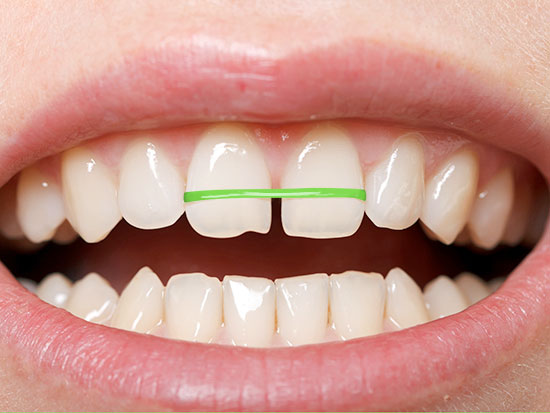 Some common tools used in at-home teeth straightening attempts include rubber bands, dental floss, fishing line, paper clips or other materials, according to the AAO.Do-it-yourself dental care is often touted as a simple fix: Straighten your own teeth without seeing an orthodontist, and save money. But something as simple as placing a small rubber band around teeth to correct imperfections can carry real consequences.
Some common tools used in at-home teeth straightening attempts include rubber bands, dental floss, fishing line, paper clips or other materials, according to the AAO.Do-it-yourself dental care is often touted as a simple fix: Straighten your own teeth without seeing an orthodontist, and save money. But something as simple as placing a small rubber band around teeth to correct imperfections can carry real consequences.
The American Association of Orthodontists is now reporting a 13 percent spike in patients’ trying DIY braces. The organization recently released a public service announcement warning about the dangers, stating “Do-it-yourself treatments can cause lasting damage.”
“It’s a very dangerous procedure if left unsupervised,” said Chung H. Kau, Ph.D., chair and professor of orthodontics at the University of Alabama at Birmingham School of Dentistry. “It’s not just about straightening teeth; it’s about function, how you bite and how you put your teeth together, and also the disease pattern in your teeth.”
The most common technique is the use of rubber bands to close the spaces between the front teeth. Many people use rubber bands from hairbands, or they can even purchase orthodontic rubber bands online. The rubber band is stretched around two or four teeth, and it will recover its original size, moving the teeth together.
Although the recent fad of DIY orthodontics, seen on YouTube and other social media platforms, has become quite popular, the use of elastics in dentistry is not a new development, according to the American Journal of Orthodontics and Dentofacial Orthopedics. One of the earliest applications of elastics was to extract teeth in patients with bleeding disorders, cardiac problems or mental deficiency. The practitioner simply placed a rubber band around the tooth to be extracted; because of the shape of teeth, the rubber band slowly worked its way up or down the sides of the tooth roots, destroying the bone and soft tissues, and the tooth just fell out, all in about four to six weeks.
Kau says any benefits are far outweighed by the risks associated with this practice. If not treated and corrected by an orthodontist, rubber bands can cause destruction of tissue, which can affect the bite, abnormal development of the teeth and temporomandibular joint (TMJ) disorder.
“Your teeth could move, but in the wrong direction, and you could cause permanent damage and eventually lose a tooth,” he said.
Associate and UAB Alumni Professor Christos Vlachos, DMD, says he hopes DIY braces does not become an even bigger trend than it is now.
“It’s downright scary, because it’s a lot more complex to move teeth,” Vlachos said. “You have to move them in three dimensions, and to do that requires a knowledge of biology of tooth movement, physics and art to do this properly.”
While some may believe the cost of braces to be expensive, the damage DIY braces cause can lead to more heartache and more money spent.
“This isn’t like fixing a leaky faucet,” Vlachos said. “People don’t do root canals or surgery on themselves, so why would they do this with braces?”
The UAB Dentistry Department of Orthodontics is active in teaching, research and service. Postdoctoral students consistently score in the upper quintile of the National Board Examination. Orthodontists receive two to three years of specialized education beyond dental school and are specialists in straightening teeth and aligning the bite.